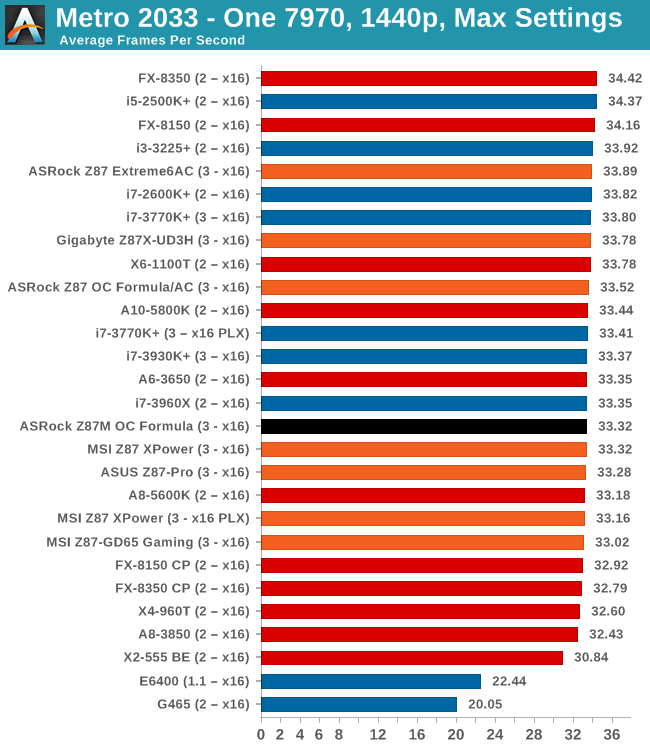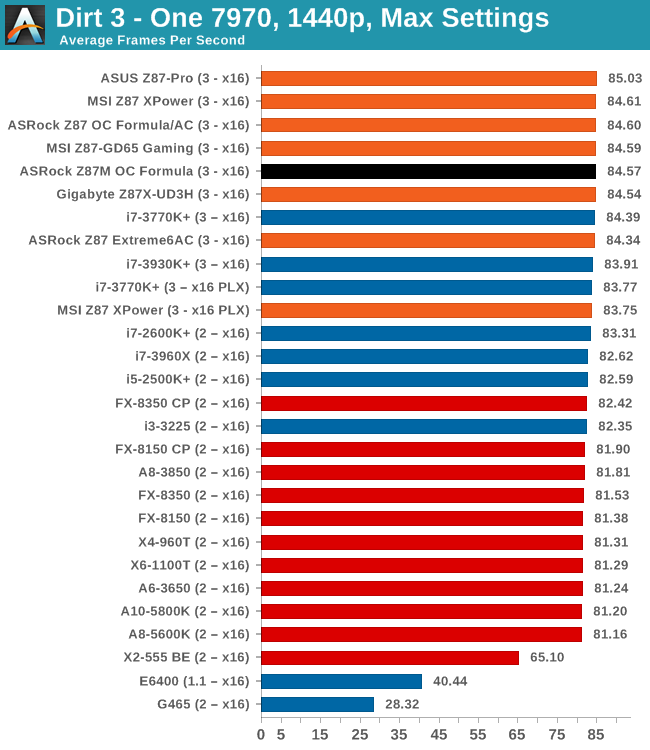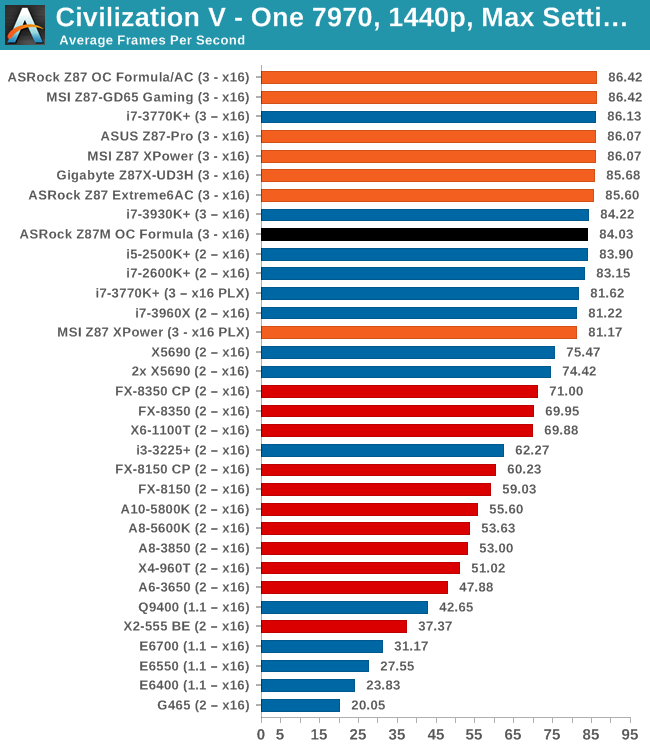ASRock Z87M OC Formula Review: mATX OC at $190
by Ian Cutress on August 14, 2013 10:00 AM EST- Posted in
- Motherboards
- ASRock
- Haswell
- Z87
Gaming Benchmarks
Metro2033
Our first analysis is with the perennial reviewers’ favorite, Metro2033. It occurs in a lot of reviews for a couple of reasons – it has a very easy to use benchmark GUI that anyone can use, and it is often very GPU limited, at least in single GPU mode. Metro2033 is a strenuous DX11 benchmark that can challenge most systems that try to run it at any high-end settings. Developed by 4A Games and released in March 2010, we use the inbuilt DirectX 11 Frontline benchmark to test the hardware at 1440p with full graphical settings. Results are given as the average frame rate from a second batch of 4 runs, as Metro has a tendency to inflate the scores for the first batch by up to 5%.

| Metro 2033 | 1 GPU | 2 GPU | |
| AMD | |||
| NVIDIA |
Dirt 3
Dirt 3 is a rallying video game and the third in the Dirt series of the Colin McRae Rally series, developed and published by Codemasters. Dirt 3 also falls under the list of ‘games with a handy benchmark mode’. In previous testing, Dirt 3 has always seemed to love cores, memory, GPUs, PCIe lane bandwidth, everything. The small issue with Dirt 3 is that depending on the benchmark mode tested, the benchmark launcher is not indicative of game play per se, citing numbers higher than actually observed. Despite this, the benchmark mode also includes an element of uncertainty, by actually driving a race, rather than a predetermined sequence of events such as Metro 2033. This in essence should make the benchmark more variable, but we take repeated in order to smooth this out. Using the benchmark mode, Dirt 3 is run at 1440p with Ultra graphical settings. Results are reported as the average frame rate across four runs.

| Dirt 3 | 1 GPU | 2 GPU |
| AMD | ||
| NVIDIA |
Civilization V
A game that has plagued my testing over the past twelve months is Civilization V. Being on the older 12.3 Catalyst drivers were somewhat of a nightmare, giving no scaling, and as a result I dropped it from my test suite after only a couple of reviews. With the later drivers used for this review, the situation has improved but only slightly, as you will see below. Civilization V seems to run into a scaling bottleneck very early on, and any additional GPU allocation only causes worse performance.
Our Civilization V testing uses Ryan’s GPU benchmark test all wrapped up in a neat batch file. We test at 1080p, and report the average frame rate of a 5 minute test.

| Civilization V | 1 GPU | 2 GPU |
| AMD | ||
| NVIDIA |
Sleeping Dogs
While not necessarily a game on everybody’s lips, Sleeping Dogs is a strenuous game with a pretty hardcore benchmark that scales well with additional GPU power due to its SSAA implementation. The team over at Adrenaline.com.br is supreme for making an easy to use benchmark GUI, allowing a numpty like me to charge ahead with a set of four 1440p runs with maximum graphical settings.

| Sleeping Dogs | 1 GPU | 2 GPU |
| AMD | ||
| NVIDIA |
Conclusions
In terms of gaming, MCT enabled or disabled does not seem to matter that much, except in Civilization V, where in dual GPU the M-OCF is 7 FPS behind the 112 scored by the normal OCF on AMD GPUs, and on one 7970 in Sleeping Dogs.










25 Comments
View All Comments
psyside1 - Friday, August 23, 2013 - link
Don't bother with other boards, if you can get ROG, period.Synomenon - Wednesday, August 14, 2013 - link
Did the specific board Anandtech tested have a C1 or C2 Z87 chipset?QChronoD - Thursday, August 15, 2013 - link
I'm disappointed about the copy/paste of the HDMI In from the last review, especially with the lame excuse of being unable to test it due to not owning a console. Seeing as how he is most likely writing the review about this motherboard on a different computer, is it really that difficult to use it as a source and do some basic testing? Do you have to use the CPU graphics to be able to switch to it? Does the HDMI In work well with multiple displays? If you have dual monitors, is it possible to control which one gets switched to the external input?nitemareglitch - Friday, August 16, 2013 - link
Anyone think this looks like the old DFI motherboards?PC Perv - Saturday, August 17, 2013 - link
The lack of enthusiasm on this review is.. palpable. ^^ Can't really blame the reviewer, to be frank. It is a shame that mobo makers are throwing everything but the kitchen sink, which are largely unfinished and useless, in order to justify overpriced Intel boards.In light of ASrock's emphasis of overclocking capability ("OC Formula"), I find the AT's overclocking verification process to be awfully inadequate. No serious overclocker will consider a POV Ray run and an unidentified OCCT run as proof of successful overclock.
One more nitpick is that Video/Audio-IN via HDMI was not tested. It seems like the most interesting feature among the bazillion junks ASrock dumped in this board. The reviewer is candid about it, which I appreciate, but it still doesn't make the review complete since the rest of stuff is not very interesting (and it is unclear whether they even work without hitches, since they were not tested) and, as aforementioned, the board's OC-ability wasn't really "tested."
So after reading this review, the board seems like a today's average board, which comes with lots of useless and half-baked features that simply fill in the questionable checkboxes.